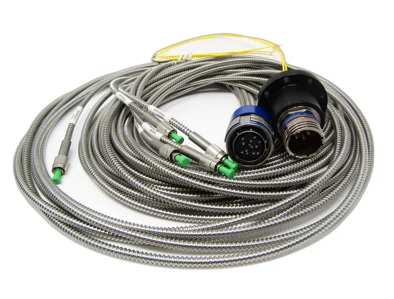What is an Electromechanical Assembly?
An electromechanical assembly combines components and subassemblies that feature electrical and mechanical design elements to perform a specific function.
For Douglas Electrical Components, we manufacture electrical connectors and feedthroughs that feature both a mechanical interface as well as electrical components to transmit power and/or signal. Our electromechanical assemblies are integrated into larger assemblies and equipment with the mechanical design feature of hermetically sealed electronics using our epoxy technology. Our proprietary epoxy seal creates a single hermetic solution that can be installed directly into the larger assembly or system.
How do we manufacture the electromechanical assembly?
First, the design process dictates the success of our products. Our Technical Sales Engineers partner with customers to combine the right features to ensure the mechanical and electrical specifications can be met.
For the mechanical interface, our team will ensure the feedthrough housing material, size, and method of installation (threads, radial O-ring, face seal, flange, etc) can withstand the pressure and environmental conditions. Additionally, material selection such as brass, stainless steel, nickel alloys, plastics, or other materials can all be considered within the design to ensure liquid and gas compatibility, strength, and cost.
The electrical portion of the electromechanical assembly also requires consideration. Our Sales Engineers work to specify the best solution for both the transmission of power and signal as well as the usage and installation within the overall assembly. Our team can combine various electrical interface types with the use of epoxy. Additionally, we will combine any value-add capabilities that are more efficient to integrate in our factory while we are manufacturing the feedthrough than once it reaches our customer. Examples include wire marking, shielding and jacketing, engraving, integral connectors, and more.
Once we receive an order, we get the design of the electromechanical assembly to our production floor, featuring LEAN manufacturing work cells with IPC-620 technicians. Our business is built upon a repeatable process to ensure our epoxy technology is deployed to hermetically seal directly to the conductor or optical fiber. Using epoxy creates a hermetic bond directly between the electrical connection and mechanical interface.

How do we test the assembly?
Testing starts with incoming inspection of materials. Douglas does partner with some of the largest and most trusted brands in the industry to ensure the highest quality assembly is manufactured. Testing of the actual electromechanical assembly is dependent on the design and application. For example, applications operating under high pressures can be tested in-house to over 10,000 PSI (700 bar) and tested using Helium mass spectrometers under vacuum. We have in-house tooling and machining capabilities to design fixtures and setups to ensure the feedthrough assembly is manufactured efficiently and to the highest quality.
We also perform electrical and optical fiber testing for each conductor within the manufacturing cell before shipment.
How can we help?
Our team is ready to take on more applications. Douglas Electrical Components has grown using a winning formula of understanding your design needs and translating them into a hermetic electromechanical assembly. We manufacture hermetic solutions for hazardous locations, explosion-proof and non-hazardous applications, including standard wire bushings, custom encapsulated circuits, hermetic connector assemblies, power feedthroughs, and optical fiber feedthroughs. Contact us with your existing or new applications!


